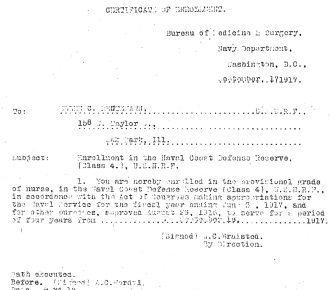Bureau of Medicine & Surgery
Navy Department
Washington DC
October 17, 1917
To: Ellen C. Rentzmann
18 Taylor
Oak Park Ill.
Subject: Enrollment in the Naval Coast Defense Reserve, (Class 4.), U.S.N.R.F
1. You are hereby enrolled in the provisional grade of nurse, in the Naval Coast Defense Reserve (Class 4), U.S.N.R.F., in accordance with the Act of Congress making appropriations for the Naval Service for the fiscal year ending June 3, 1917, and for other purposes, approved August 29, 1916, to serve for a period of four years from September 18, 1917.
(Signed) W.C.Braisted.
By Direction.
Oath executed.
Before. (Signed) A.C. Nordil
Date. 9-24-17
Commission Expires May 4, 1919.
ALWAYS KEEP THIS PAPER
Certified to be a true copy.
signed by Ellen C. Rentzmann
Historical Notes
1. W.C. Braisted referred to Navy Surgeon General William C. Braisted (who had been born the year before Lincoln was assassinated). While the War effort was uppermost, an even greater challenge lay ahead for the Navy’s caregivers. The story is retold by Braisted himself, but a 2010 NIH report offers this shorter account:
. . . in the fourth dreadful year of the war, as the American Expeditionary Forces (AEF) assumed fighting strength and prepared their first great offensive against the Germans, the flu struck. By the War Department’s most conservative count, influenza sickened 26% of the Army—more than one million men—and killed almost 30,000 before they even got to France.2,3 On both sides of the Atlantic, the Army lost a staggering 8,743,102 days to influenza among enlisted men in 1918.4 (p. 1448) The Navy recorded 5,027 deaths and more than 106,000 hospital admissions for influenza and pneumonia out of 600,000 men, but given the large number of mild cases that were never recorded, Braisted put the sickness rate closer to 40%.5,6 (p. 2458)
